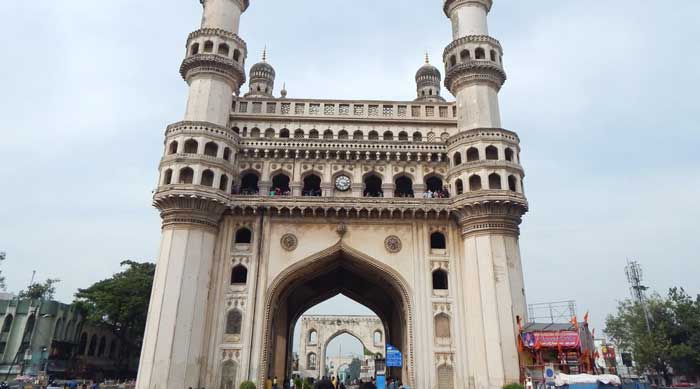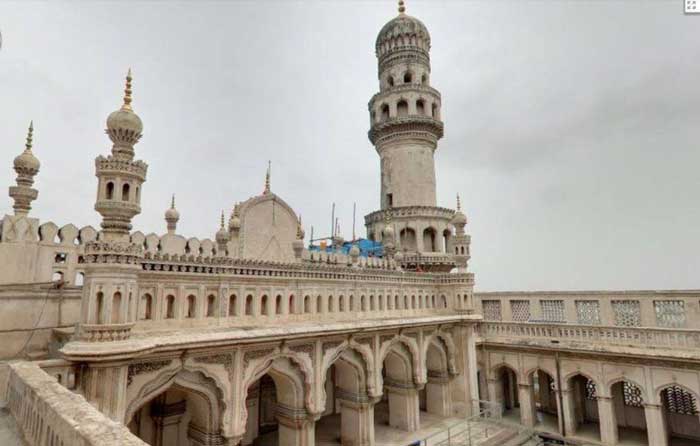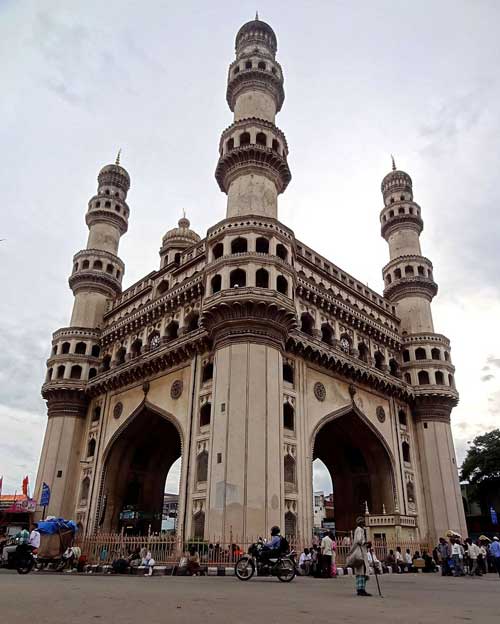
Located in the heart of the old city of Hyderabad, the Charminar stands regally tall amidst the colourful bangle shops in the heart of the winding and rambling Laad Bazar. The area never ceases to throb, as this part of the city smells and feels like the real Hyderabad. Designed for a new capital, the city of Hyderabad was planned with the Charminar at its centre, spreading around in four quadrants along the four cardinal directions. Built on the eastern banks of the Musi River in an amazing blend of Indo-Islamic architectural style, the imposing structure was strategically set at the intersection of the historical trade route connecting Golkonda with the important port city of Machhilipatnam.
Muhammad Quli Qutub Shah, the fifth Sultan of the Qutub Shahi Dynasty, shifted his capital from Golkonda to ‘Bhagyanagar’, named after his beloved Hindu queen 'Bhagmati'. Later, when Bhagmati embraced Islam and took the name Hyder Mahal, Bhagynagar was also renamed Hyderabad after her. It is said that, at a time of distress, Muhammad Quli Qutub Shah prayed for the end of a ravaging plague and vowed to build a mosque if it was eradicated. He kept his promise and to celebrate the end of the deadly disease, the Makka Masjid and the Charminar were built in 1591.

During that time, at the instance of Quli Qutub Shah, Mir Momin Astrabadi, his chief minister, designed the city of Hyderabad, with the Charminar at its centre. The city was divided into four divisions equally around the Charminar, which was built in Indo-Islamic architectural style, with ample Persian elements in it. The layout of the city was based on a regular grid filled with houses, palaces, monuments, Markets and squares around the central plaza with Charminar.
However, according to the accounts of Jean de Thevenot, a French traveler, the Charminar was constructed to commemorate the beginning of the second Islamic millennium year (1000 AH, in the year of the Hijra), which is celebrated far and wide in the Islamic world, and thus Qutub Shah founded the city of Hyderabad to celebrate it with the construction of this building.

The magnificent edifice is built of granite and lime mortar or pulverised marble with stucco ornamentation. It is a perfectly square structure, with each side measuring 66 feet (20 m) and facing one of the cardinal directions. The four grand arches, one on each side, open into four different streets, are 36 feet (11 m) wide at the base and reaches 66 feet high at its apex. The name Charminar, which means ‘four pillars’ originated from its structure, which includes four intricately carved fluted pillars, built one in each corner. Unlike other prominent Islamic monuments, like the Taj Mahal, the minarets of Charminar are built into the main structure and are integral parts of it. The exquisite minarets, soaring about 184 feet high (56 m) up in the sky are equipped with two balconies, and are crowned with small delicate domes with dainty petal-like designs at the base. Spiral staircases with 149 winding steps and 12 landings are complemented with each of the minarets. The landings feature a delicately colonnaded covered walkway around the exterior wall. The arches and the domes of the building indicate the influence of Islamic architecture, while the minarets reflect Persian influence.


There are two floors above the arches of the main structure. During the Quṭub Shāhī era, the first floor was used as a madrasa (Islamic school). In the western side of the second floor, there is a small mosque, which is supposed to be the oldest mosque of the city. In early days, the eastern part served as the court at the time of Sultan Qutb Shah. The actual mosque occupies the top floor of the four-storey structure. Apart from that, there are two galleries inside the Charminar. The main gallery of the Minar accommodates 45 covered prayer spaces along with a large open space, which is still visited by the devotees, especially on the Fridays.
Four clocks were added in 1889, atop the apex of the four grand arches, along the four cardinal directions. In the middle of the courtyard, a small fountain provides water for the ritual washing for the Muslims, before they offer prayer in the Mosque.


After the end of the Qutub Shahi Dynasty and during the Mughal governorship of Hyderabad, the southwest minaret of Charminar was demolished, after being struck by lightning. The damage was repaired at a cost of Rs. 60.000. In 1824, the monument was repaired at a cost of Rs. 100.000.

The Chrminar, is the splendid architectural icon of the city of Hyderabad. Considered to be among the top ten monuments of India, it is often called the Arc de Triomphe of the east. Currently maintained by the Archeological Survey of India, it presents a mesmerizing glittering sight after evening, when it is illuminated.